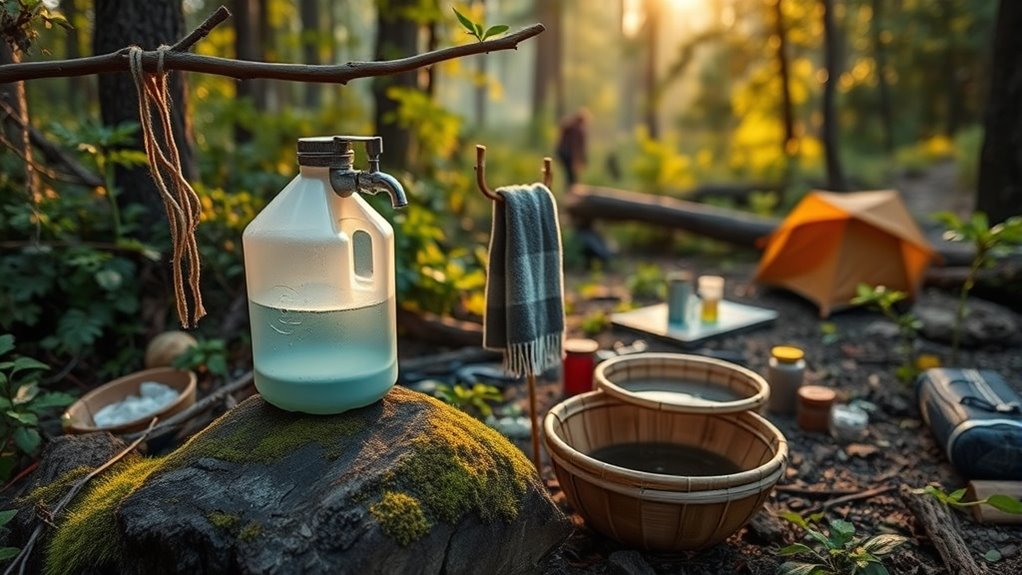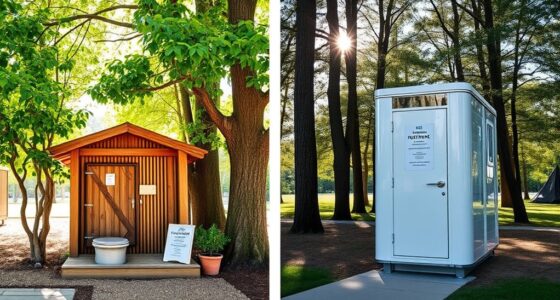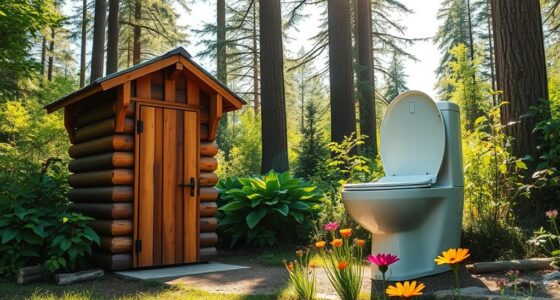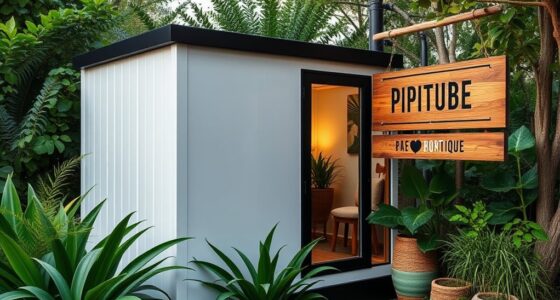When camping in remote areas, bring biodegradable soap and a collapsible sink or water bottle with a spout for easy handwashing. Use portable water filters or UV sterilizers to guarantee safe water for cleaning. Illuminate your campsite with lanterns or headlamps to spot dirt and germs more effectively. Proper tools and techniques keep your hands clean and reduce wildlife attraction. Keep exploring to discover even more innovative hacks to stay hygienic in any wilderness setting.
Key Takeaways
- Carry biodegradable soap and collapsible sink or water bottle with spout for convenient handwashing with limited water.
- Use portable UV sterilizers to quickly sanitize hands and utensils in low-resource settings.
- Illuminate handwashing areas with solar-powered lights or headlamps to improve visibility and thorough cleaning.
- Design a simple, gravity-fed handwashing station using a large container and spigot for easy access.
- Pack hand sanitizers as a quick, effective alternative when water access is severely limited or unavailable.
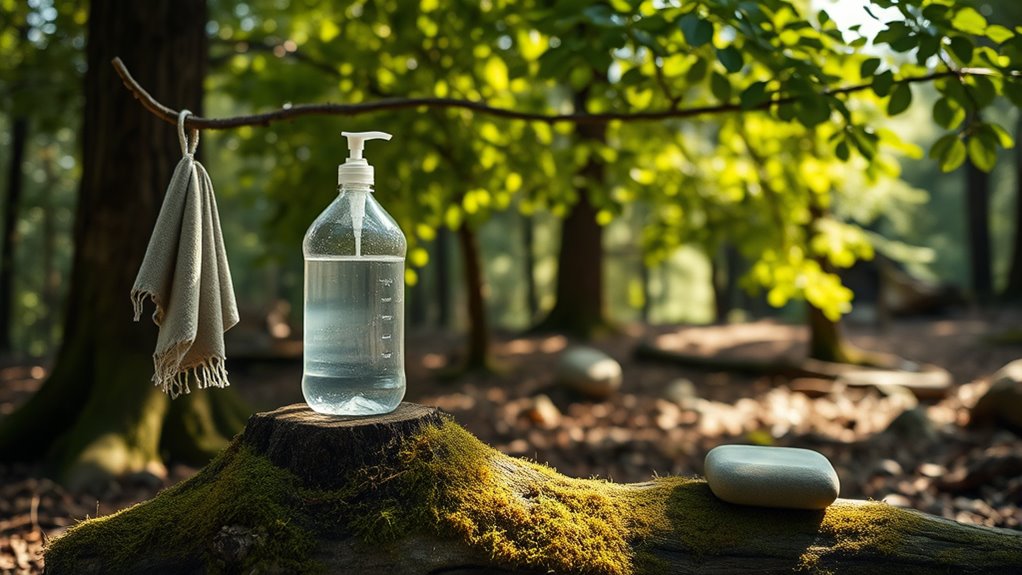
Camping can be a fun adventure, but maintaining good hygiene in the great outdoors is essential for comfort and health. When you’re out in the wilderness, basic hygiene practices become even more critical to prevent illnesses and keep your camping experience enjoyable. One of the best ways to stay clean is by setting up a reliable hand-wash station. Portable hand sanitizers are convenient, but nothing beats washing your hands with water and soap whenever possible. If water access is limited, consider carrying biodegradable soap and a collapsible sink or bottle with a spout. This way, you can wash your hands thoroughly after handling food, using the restroom, or before preparing meals.
Speaking of food, campfire cooking is a highlight for many campers, but it also demands strict hygiene. Always wash your hands before cooking and after handling raw ingredients. Use designated utensils and cutting boards to avoid cross-contamination. When preparing meals, keep raw meat separate from fresh produce, and clean your cooking surfaces regularly, preferably with biodegradable wipes or soap and water. Maintaining cleanliness during campfire cooking not only enhances safety but also preserves the flavor of your meals. After cooking, dispose of food scraps properly and clean your cookware and utensils promptly to prevent attracting wildlife.
Always wash hands and keep raw meat separate during campfire cooking for safety and flavor.
Outdoor lighting plays a significant role in maintaining hygiene after sunset. When it gets dark, good lighting allows you to see what you’re doing clearly. Use headlamps, lanterns, or solar-powered lights to keep your campsite well-illuminated. Proper lighting helps you spot dirt, debris, or even small pests on your hands, utensils, and surfaces, enabling you to clean effectively. It also makes it easier to locate your hygiene supplies and ensure that your hands are thoroughly washed or sanitized before touching food or your face. Additionally, bright lighting deters unwanted critters from creeping into your campsite, which can carry germs or cause contamination.
In remote locations, where running water and power are scarce, innovation is key. Portable water filters and UV sterilizers can help guarantee your water is safe for washing and drinking. Combining these with effective outdoor lighting and proper campfire cooking techniques keeps your hygiene routine manageable and efficient. Staying vigilant about cleanliness, even in the wilderness, isn’t just about comfort — it’s about protecting yourself from preventable illnesses. A high-quality projector can also enhance your indoor or outdoor movie nights, making your camping experience even more memorable. With the right tools and habits, you can enjoy the outdoors while maintaining the hygiene standards that keep you healthy and comfortable throughout your adventure.
Frequently Asked Questions
Can I Use Biodegradable Soap for Hand Washing at Campsites?
Yes, you can use biodegradable soap for hand washing at campsites. It contains biodegradable ingredients that break down naturally, making it eco-friendly and safe for the environment. Just guarantee you use soap safety practices by disposing of the soapy water properly, away from water sources. This way, you protect the environment while keeping your hands clean, especially in remote locations where ecosystem preservation is vital.
How Do I Prevent Soap From Contaminating Water Sources?
You worry about soap contaminating water sources, but with proper soap disposal, you can prevent this. Research shows biodegradable soap breaks down quickly, reducing environmental impact. To protect water, use minimal soap and keep it away from streams or lakes, focusing on water conservation. Dispose of soap residue at least 200 feet from water bodies, and always follow Leave No Trace principles to keep the environment pristine.
What Are Eco-Friendly Alternatives to Hand Sanitizer?
You’re looking for eco-friendly alternatives to hand sanitizer, and natural disinfectants are a great option. You can use solutions like diluted vinegar or tea tree oil, which are effective and biodegradable. Always store these in reusable containers to reduce waste. These options help you maintain hygiene while protecting the environment, especially in remote locations where eco-conscious choices make a significant difference.
How Often Should I Disinfect Camping Gear and Surfaces?
You should sanitize your camping gear and surfaces regularly, especially after touching shared equipment or coming into contact with potential contaminants. Doing so helps extend your gear’s longevity and prevents surface contamination. Typically, disinfect high-touch areas daily or after use in dirty environments. Consistent cleaning reduces bacteria buildup, keeps your gear in good shape, and ensures a safer, more enjoyable camping experience.
Are There Portable Hand-Washing Stations Suitable for Remote Locations?
You’ll find that portable wash stations and hand sanitizing stations are perfect for remote locations. They’re designed to be lightweight, easy to set up, and effective in maintaining hygiene when traditional facilities aren’t available. Whether you need a simple hand-washing station or a more thorough setup, these innovations guarantee you can stay clean and healthy, no matter how far off the grid you go.
Conclusion
Just like a well-tended campfire keeps your adventure safe and warm, maintaining hygiene in remote spots protects you from unseen dangers. Remember the hiker who skipped hand-washing and ended up battling stomach bugs? Don’t let that be your story. With these simple hacks, you’ll keep germs at bay and enjoy every moment outdoors. Think of your hygiene routine as the sturdy tent that shields you — essential, reliable, and worth every effort.
